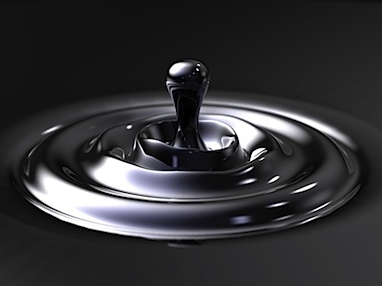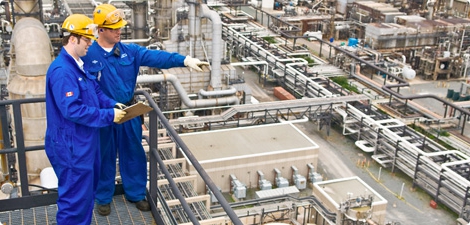Oil is a mineral, which is an insoluble oily liquid in water, which can be almost colorless or dark brown. The properties and methods of oil refining depend on the percentage of predominantly hydrocarbons in its composition, which varies in different fields.
So, in the Sosninskoye deposit (Siberia), alkanes (paraffin group) occupy a share of 52 percent, cycloalkanes - about 36%, aromatic hydrocarbons - 12 percent. And, for example, in the Romashkinskoye deposit (Tatarstan), the share of alkanes and aromatic carbons is higher - 55 and 18 percent, respectively, while cycloalkanes have a share of 25 percent. In addition to hydrocarbons, this raw material may include sulfur, nitrogen compounds, mineral impurities, etc.

Oil was first "refined" in 1745 in Russia
In its raw form, this natural resource is not used. To obtain technically valuable products (solvents, motor fuels, components for chemical production), oil is refined using primary or secondary methods. Attempts to convert these raw materials were made as early as the middle of the eighteenth century, when, in addition to candles and torches used by the population, “garne oil” was used in the lamps of a number of churches, which was a mixture of vegetable oil and refined oil.
Oil refining options
Refining is often not directly involved in oil refining processes. Rather, this is a preliminary stage, which may consist of:
- Chemical cleaning when oil is exposed to oleum and concentrated sulfuric acid. This removes aromatic and unsaturated hydrocarbons.
- Adsorption treatment. Here, resins and acids can be removed from petroleum products by treatment with hot air or by passing oil through an adsorbent.
- Catalytic treatment - mild hydrogenation to remove nitrogen and sulfur compounds.
- Physical and chemical cleaning. In this case, excess constituents are selectively released by means of solvents. For example, the polar solvent phenol is used to remove nitrogen and sulfur compounds, while non-polar solvents - butane and propane - emit tar, aromatic hydrocarbons, etc.
No chemical changes ...
Oil refining through primary processes does not imply chemical transformations of the feedstock. Here, the mineral is simply divided into its constituent components. The first oil distillation device was invented in 1823, in the Russian Empire. The Dubinin brothers guessed to put the boiler in the heating furnace, from where the pipe went through a barrel of cold water into an empty container. In the furnace boiler, oil was heated, passed through a “refrigerator” and precipitated.
Modern methods of preparing raw materials
Today, at oil refining complexes, oil refining technology begins with additional purification, during which the product is dehydrated on ELOU devices (electric desalting plants), freed from mechanical impurities and light carbohydrates (C1 - C4). Then the raw materials can go to atmospheric distillation or vacuum distillation. In the first case, the factory equipment by the principle of operation resembles that which was used as early as 1823.
Only the oil refinery itself looks different. At the enterprise there are stoves, in size resembling houses without windows, made of the best refractory bricks.Inside them are multi-kilometer pipes, in which oil moves at high speed (2 meters per second) and is heated to 300-325 C with a flame from a large nozzle (at higher temperatures, hydrocarbons simply decompose). Distillation columns (up to 40 meters high) are replacing the pipe for condensation and cooling of vapors today, where the vapors are separated and condensed, and whole towns from different tanks are built to receive the products received.

What is material balance?
Oil refining in Russia gives different material balances in the atmospheric distillation of raw materials from a particular field. This means that at the output different proportions can be obtained for different fractions - gasoline, kerosene, diesel, fuel oil, associated gas.
For example, for West Siberian oil, gas yield and losses are one percent, respectively, gasoline fractions (released at temperatures from about 62 to 180 C) occupy about 19%, kerosene - about 9.5%, diesel fraction - 19% , fuel oil - almost 50 percent (allocated at temperatures from 240 to 350 degrees). The resulting materials are almost always subjected to additional processing, since they do not meet the operational requirements for the same machine engines.
Less waste production
Vacuum processing of oil is based on the principle of boiling substances at a lower temperature with a decrease in pressure. For example, some hydrocarbons in oil boil only at 450 ° C (atmospheric pressure), but they can be forced to boil at 325 ° C if the pressure is lowered. Vacuum processing of raw materials is carried out in rotary vacuum evaporators, which increase the distillation rate and make it possible to obtain ceresins, paraffins, fuels, oils from fuel oil, and use the heavy residue (tar) further for the production of bitumen. Vacuum distillation, compared with atmospheric processing, produces less waste.

Recycling allows you to get high-quality gasolines
The secondary oil refining process was invented in order to get more motor fuel from the same feedstock due to the effect on the molecules of petroleum hydrocarbons, which acquire formulas that are more suitable for oxidation. Recycling includes various types of so-called "cracking", including hydrocracking, thermal and catalytic options. This process was also originally invented in Russia, in 1891, by an engineer V. Shukhov. It is a splitting of hydrocarbons into forms with fewer carbon atoms in one molecule.
Oil and gas processing at 600 degrees Celsius
The principle of operation of cracking plants is approximately the same as the atmospheric pressure settings of vacuum plants. But here the processing of raw materials, which is most often represented by fuel oil, is carried out at temperatures close to 600 C. Under this influence, the hydrocarbons that make up the fuel oil mass break up into smaller ones, of which the same kerosene or gasoline consists. Thermal cracking is based on high temperature treatment and gives gasoline with a large amount of impurities, catalytic cracking also on heat treatment, but with the addition of catalysts (for example, special clay dust), which allows to obtain more gasoline of good quality.
Hydrocracking: main types
Oil production and refining today may include various types of hydrocracking, which is a combination of hydrotreatment processes, the breakdown of large hydrocarbon molecules into smaller ones and the saturation of unsaturated hydrocarbons with hydrogen. Hydrocracking is easy (pressure 5 MPa, temperature about 400 C, one reactor is used, it turns out mainly diesel fuel and material for catalytic cracking) and hard (pressure 10 MPa, temperature is about 400 C, several reactors are obtained, diesel, gasoline and kerosene fractions). Catalytic hydrocracking allows the production of a number of oils with high viscosity coefficients and a low content of aromatic and sulfur type hydrocarbons.

Oil refining, in addition, can use the following processes:
- Visbreaking.In this case, at temperatures up to 500 C and pressures ranging from half to three MPa, secondary asphaltenes, hydrocarbon gases, and gasoline are obtained from raw materials by splitting paraffins and naphthenes.
- Coking of heavy oil residues is a deep oil refining when raw materials are processed at temperatures close to 500 C under a pressure of 0.65 MPa to produce gas oil components and petroleum coke. The stages of the process end with a “coke cake”, which is preceded (in reverse order) by densification, polycondensation, aromatization, cyclization, dehydrogenation and cracking. In addition, the product is also subject to drying and calcination.
- Reforming. This method of processing petroleum products was invented in Russia in 1911, engineer N. Zelinsky. Today, reforming the catalytic plan is used in order to obtain high-quality aromatic hydrocarbons and gasolines, as well as hydrogen-containing gas from ligroin and gasoline fractions for subsequent processing in hydrocracking.
- Isomerization. Oil and gas processing in this case involves obtaining an isomer from a chemical compound due to changes in the carbon skeleton of a substance. So from high-octane oil components, high-octane components are isolated to produce marketable gasolines.
- Alkylation. This process is based on the incorporation of alkyl substituents into an organic molecule. Thus, components for high-octane gasolines are obtained from unsaturated hydrocarbon gases.
Striving for European standards
The technology of oil and gas processing at the refinery is constantly being improved. So, at domestic enterprises there was an increase in the efficiency of processing of raw materials by parameters: the depth of processing, an increase in the selection of light petroleum products, a decrease in irretrievable losses, etc. The refineries' plans for the 10-20s of the twenty-first century include a further increase in the processing depth (up to 88 percent) , improving the quality of products to European standards, reducing technological impact on the environment.








